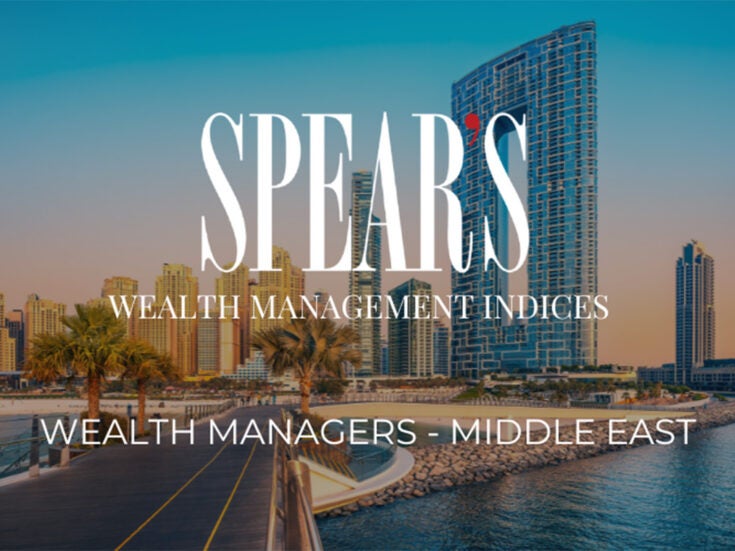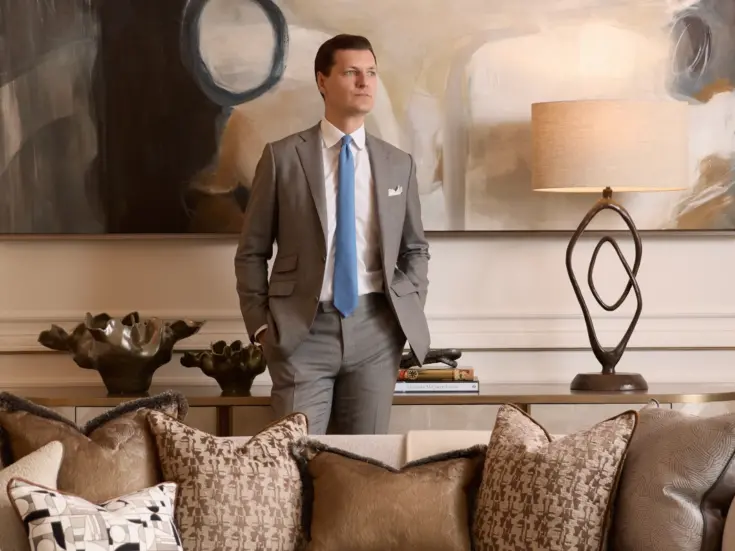
Peter Lürssen is at the helm of the most ambitious superyacht builder in the world, writes Edwin Smith
Peter Lürssen is a generous man. I learned this when we had lunch together in London one day this summer. At Kai, an upscale Chinese restaurant in Mayfair, we sat, spoke, drank white wine and made our way through what seemed like the entirety of a long and excellent menu. After a couple of hours, as another round of plates was being cleared, Lürssen said: ‘Are you ready for the main course?’
He was joking – sort of. After this, he ordered several desserts for the table, including one called Oprah’s Contradiction. (Oprah once said, ‘You can have it all. You just can’t have it all at once.’ This was the pudding that proved her wrong.)
But Lürssen is generous in another sense too. A little while ago he quietly agreed to fund the entirety of Blue Marine Foundation’s operating budget for five years. There was no big announcement at the time, but he is willing to speak about the decision now. ‘It’s quite difficult, making people part with their money,’ Lürssen told me.
But by covering the operating costs of Blue Marine Foundation (BLUE) – and allowing the charity to assure other donors that every penny they give goes directly to projects – he hopes to encourage more people to support BLUE’s work. ‘You can give those people who donate the money [directly to projects] the sense of ownership and pride in the achievement, which is very important.’
He noted that some charities – none of which he would name – are able to host a nice cocktail reception at the Monaco Yacht Show. But that isn’t the same as actually achieving something. ‘It’s good for your conscience,’ he said. ‘But does it get you anywhere? I always feel life is too short – especially when you’re over 60, like me – to waste your energy and your resources on something that is not getting proper results. And that is something that I really like about BLUE. They do get results.
As a result, Lürssen has donated more money to BLUE. On top of his contribution to cover the operating costs of the charity, he donated an additional £2 million to fund a project to create a marine protection area around Ascension Island, a remote a island in the Atlantic. (The project is described in more detail in a piece written for Spear’s by BLUE Ambassador HRH Princess Eugenie and the charity’s CEO Clare Brook.)
‘The ocean is the one thing that connects us all. And the more you think about it and look into it and read about it, you realise how important the oceans really are to the world. It’s way beyond the supply of fish. It’s way beyond swimming. You know, it’s a hugely important factor for us to be able to live on this earth.’
Lürssen is able to support BLUE in such a way thanks to his stewardship of Lürssen Yachts. During his time at the company, the nearly 150-year-old family business has been transformed from an industrial firm producing products for the defence sector into a true luxury brand, and perhaps the leading builder of superyachts in the world.
As CEO he has presided over the delivery of one extraordinary, ground-breaking vessel after another. These include the 180-metre Azzam, which is capable of more than 30 knots and, at one point, was the longest superyacht in the world, and Dilbar.
Launched in 2016, at 156 metres long and more than 23 metres wide, Dilbar became the biggest yacht in the world by gross tonnage. The company – which fiercely guards the privacy of its clients – has also produced vessels for late Microsoft co-founder Paul Allen, record producer David Geffen and members of Middle-Eastern royalty.
Over lunch, I asked him about his life, his career and where Lürssen is headed next.
***
Did you always want to join the family business, or did you feel pressure to do so?
It just was just a natural development. I never felt the pressure. Really, you know, after [leaving school] I was told to do that. But I would never rebel against that decision because I knew it would be good. I wasn’t questioning the wisdom of running the business.
My cousin was even born in the shipyard, so it was a very deep natural relationship with the people, with the business. And it was normal for us. I cannot remember ever wanting to do something like be a fireman or an astronaut. Shipbuilding was always very much a fascination.

When you first came into the business, it was largely reliant on the defence sector for work. But a lot of Lürssen’s growth over the last couple of decades has come from yachting. How did that transition happen?
Well the first challenge that I had, was to tell my family, ‘Look, I know I’m the engineer, and you think I should be the technical director, but it is a no-go.’ To run production, I told them, ‘your brain has to be wired in a particular way.’ I just can’t do that. I realised that very early on.
When I came into the business, our output was about 95 per cent defence and naval, and the rest was miscellaneous. My uncle used to joke that every 10 years we can allow ourselves to build a yacht. We built Carinthia V and VI. We built a boat called Shergar, which was quite special. But then in ‘87, ‘88 diversification was a big thing and we had a seminar.
The idea – I think they call it the trumpet model – was to [sketch out] the best case and the worst case scenario. And if you prepare for both, you’ll be prepared for something in the middle. At that seminar we looked at fast aluminium ferries, or yachts. We had done a lot of yachts in the 1920s.
We built a few yachts after the war, but just a handful really. Luckily we decided not to go for ferries but to go for yachts. And that was the job I took on in ‘88: trying to start a yacht business.
It always sounds good to say ‘and the rest is history’. But that is a rather bold statement – and it is not really true. It was exciting, but it wasn’t easy. We had a hard time selling the first yacht. It turned out that the buyer was not able to pay and we had to repossess the vessel.
But things improved, clearly.
I must say I’ve really been fortunate. We had an amazing client, who’s been really good for us, for whom we did Coral Island – an amazing boat, really beautiful. And then there was an American who really liked Carinthia VI and he commissioned Jon Bannen-berg to redo it. Jon was trying to change the design. But the client said, ‘No, no. I want it like Carinthia.’ That was Limitless.
Commercially it was not really a success. But after that we sold a very large yacht to a client who cancelled. That yacht [was taken on by another client] and is now called Dubai. It’s 162 metres with an amazing design by Andrew Winch.
Since then we’ve been very fortunate that we did a few things right. And we managed to weather all the tough times in yacht-building and the dotcom crisis and everything. We managed to get through that intact.

How did you build Lürssen’s reputation?
We did really bespoke, unusual yachts. And clients like the idea of bespoke. In those days, it was very popular to recycle your own engineering. But we managed to keep the question of bespoke very much at the forefront. And I think that was something that was always helping us.
Today, how is the business divided up?
I would say about 50 per cent yachts and 50 per cent defence, in terms of revenue. We build a lot of 60-metre yachts. We actually build more yachts under 90 metres than over 90 metres, which people don’t realise. But, obviously, the big boats gather lots of publicity.
What do your clients want?
Clients who talk to us and our colleagues from northern Europe, they want top quality – no compromise. They want bespoke.
You’ve mentioned the popularity of things like aft swimming decks and glass bottoms in the past. What features are popular now?
It started with a gym. Now the trend is for a full spa, a sauna, cryosauna, hammam, massage, beauty treatments… And so you see guests really want to enjoy things on the boat. In the old days it was quite normal that the yacht crew would book a spa day in a hotel. They don’t do that anymore. Now clients want to have things on the yacht.
And it makes sense at the moment, in particular.
I can see, especially with Corona, people are spending more time on their yacht. It’s very safe. This really offers you ‘bubble protection’, so to speak, by being able to live in a very controlled environment.
For you, what’s the definition of ‘good design’?
I think the secret to a good design is a very good understanding of what it is the client wants. Designers shouldn’t design for themselves. They should design for the client.
How do you make sure your clients get that? What’s the process like for someone who comes to you?
A shipbuilder is really only, at best, a facilitator. We have people who come to us with a readymade design and we have people who come to us and say: ‘I want a boat, I need you to help me.’ And everything in between.
Generally, we regard it as our obligation to make sure that what the designer designs can be built; you need space for air conditioning, the engine and all that stuff.
Sometimes you organise a beauty contest for the designers. But even that comes down to the question of chemistry. If the owner or their partner doesn’t get along with the designer, it doesn’t work.
* * *
Increasingly, one of the things that clients want is for superyachts to become more sustainable. This is something that Lürssen and those he describes as his ‘Dutch colleagues’ – firms such as Feadship and Heesen – are working on.
Earlier this year his own company led the way by announcing that it was working on a new yacht that would incorporate methanol fuel cells. According to the firm, the new technology will provide its owner, ‘who loves technology and new developments,’ with 15 nights of power at anchor, or enable the craft to slow-cruise for more than 1,000 miles – emission free. The yacht is expected to be delivered in 2025.
‘My grandfather built the world’s first motorboat in 1886,’ said Lürssen at the launch. ‘My dream is to be the first to build a yacht without a combustion engine.’ But he acknowledged to me that the transition would not be easy. ‘You can’t just flick a switch.’ It is far from clear which technologies and fuels will provide the best solutions in the medium-term future.
‘There’s no element of greenwashing with him,’ noted William Mathieson, editorial director of the Superyacht Group. ‘It’s all about the optimisation of performance, process and efficiency. He can see the contradictions associated with lithium mining, for example. In some respects it could be a step in the right direction, but it might also be damaging.’
As an engineer, Lürssen is also adamant about the need to look at the whole system. ‘I think we face two difficulties with batteries,’ he said. ‘One is the power: energy density. How much energy can be stored in a cubic metre? And the second thing is, how quickly can you charge it?
Let’s assume someone invents a fantastic battery and one cubic metre of your battery equals one cubic metre of diesel fuel, in terms of energy content. That is a good thing. And let’s assume that the weight is not prohibitive. So the next thing is, where are you going to charge your batteries? If you put them next to a coal fired power station, actually, it may not have achieved the target.’
On the bright side, he added, more and more clients are ‘willing to compromise’ in order to achieve fuel-saving and emission-reduction. ‘The trend is very clear.’
* * *
Is it helpful to be a family business at a moment like this, when the future – regarding power systems and so on – is uncertain?
Yes, it does help because you can take a long-term view. It’s two things. One, it gives the client comfort if you, as a family member, stand behind the product. And you don’t have the pressure of always looking at the stock price. It’s not about – not only about – making money. It’s about client satisfaction in the end. And, ultimately, it will pay back. The clients realise you’re trying very hard to make them happy.
Next year is Lürssen’s 150th anniversary. Has it started to make you think about succession? You’ve got three adult children – might any of them come into the business?
I always think about it. But it’s very much a double-edged sword. The price a family pays in this business is not to be underestimated. A children’s birthday, or a client visit? There’s no question: you have to choose the client visit. I’m not certain that I would want the children to have to live that kind of life, and I wonder if this in the future will be as critical as today. So yes, I think about it, but I don’t have an answer for that yet.
When you say you’re not sure if it will be as critical in the future as it is today, do you mean that this is a strategically important moment for the company, the industry?
Yes. Business is getting more technocratic. Unless you have a family member who’s really deep into the technical things, it doesn’t help: you’re either in it or you’re not. And to be in so deeply, there’s a price to pay.
Have any of your children expressed an interest in joining the business?
They like the business. But they don’t like it enough to go that route for the time being. Will I be able to convince them otherwise? Honest answer: I don’t know.
Would you like to?
Yes and no. It’s great to do it. But I see all sides of it. And would I want them to go through that? I don’t know.
You’ve still got plenty of time left, of course. How would you describe your style as a leader?
That’s another difficult question. [He laughs.] I think people know that I expect a lot. I hope they also know that as long as they try their best, I’ll back them up. I will not go to the client and tell them, ‘It wasn’t my mistake – it was a guy on the shop floor that did it’. If anyone made a mistake, it’s my head on the block, not my people.
And I would do that in any situation if a client had a complaint. I stand in front of my people. But at the same time, I want a commitment from them. And I think they realise that we as a family are very committed to maintaining the business and to guaranteeing their employment. We try to do that. It’s a mutually dependent situation.
Feature image: Oliver Reetz
More from Spear’s
Philanthropy: Princess Eugenie on Ascension Island’s sustainable fishing success story
The best tax lawyers for high-net-worth individuals
Spear’s Wealth Insight Forum 2021: Watch on demand now









